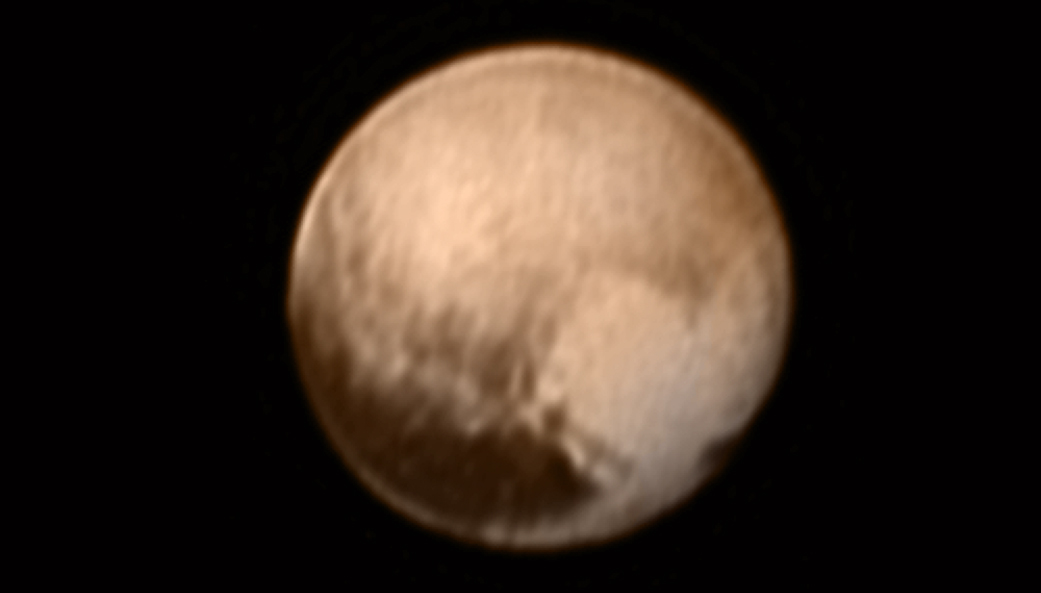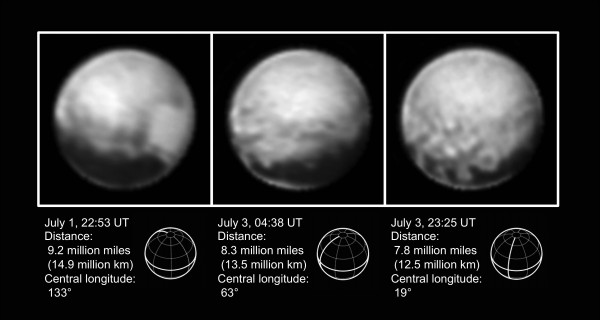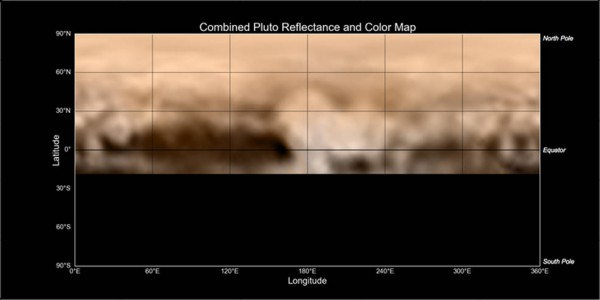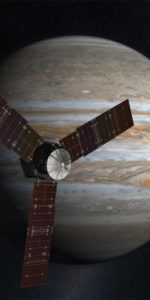
With less than six days remaining now until closest approach, Pluto is starting to show its real face for the first time ever, including a big “heart.”
The newest image released this morning shows the mottled surface of the dwarf planet in greater detail than ever before, taken by the Long Range Reconnaissance Imager (LORRI) camera aboard the New Horizons spacecraft. The image, taken July 7, is the first one to be sent back after the nail-biting anomaly occurred on the spacecraft on July 4 (which has now been resolved). New Horizons was just under 5 million miles (8 million kilometers) at the time. The images will only get better as the spacecraft gets closer to Pluto and its moons, with closest approach July 14.

“The next time we see this part of Pluto at closest approach, a portion of this region will be imaged at about 500 times better resolution than we see today,” said Jeff Moore, Geology, Geophysics and Imaging Team Leader of NASA’s Ames Research Center. “It will be incredible!”
In this newest image, the view is centered approximately on the region which will be seen the closest during the flyby; this area of Pluto is very mottled with bright and dark regions. The most prominent dark area, on the equator, has been dubbed the “whale” for its elongated shape, and is about 1,860 miles (3,000 kilometers) long. Nearby is a large bright area about 1,200 miles (2,000 kilometers) across, which is roughly heart-shaped, with one “lobe” of the heart looking more squarish than rounded. The bright areas are thought to be regions of frozen methane, nitrogen, and/or carbon monoxide frost or ice. At the left end of the whale’s “tail” is the bright donut-shaped feature about 200 miles (350 kilometers) across.
Elsewhere on Pluto are four other large dark spots along the equator, each about 300 miles (482 kilometers) across and a brighter donut-shaped feature. Other brighter features, which look like raised bumps, can also be seen just above the dark spots. What any of these intriguing features are isn’t known yet, but the view will be much better the closer New Horizons gets to Pluto. In general, these images are reminiscent of the first early Mars photos sent back by space probes or as the planet was first seen in telescopes. There are also similarities in appearance to Titan, although the processes occurring on Pluto are much different than either Titan or Mars. Pluto is indeed a unique world on its own.

A new map of Pluto based on current images has also been released, created from images taken from June 27 – July 3, 2015. The center of the map is the region which will be seen the closest during the flyby. The maps will also improve in the days ahead.
“We’re at the ‘man in the moon’ stage of viewing Pluto,” said John Spencer of the Southwest Research Institute, Boulder, Colo, deputy leader of the Geology, Geophysics and Imaging team. “It’s easy to imagine you’re seeing familiar shapes in this bizarre collection of light and dark features. However, it’s too early to know what these features really are.”
Now that New Horizons has safely recovered from the computer anomaly on July 4, it is all systems go for closest approach on July 14.
“This is a speed bump in terms of the total return we expect to receive from this historic mission,” said Alan Stern, New Horizons principal investigator with the Southwest Research Institute, Boulder, Colo. “When we get a clear look at the surface of Pluto for the very first time, I promise, it will knock your socks off.”
Stay with AmericaSpace for regular updates and LIVE COVERAGE of New Horizons’ approach and flyby of the Pluto system.
Be sure to “Like” AmericaSpace on Facebook and follow us on Twitter: @AmericaSpace





2 Comments
2 Pings & Trackbacks
Pingback:Closing in on Pluto: dwarf planet shows its face and heart
Pingback:New Images and Scheduled Observations of Pluto as New Horizons Closes In « AmericaSpace